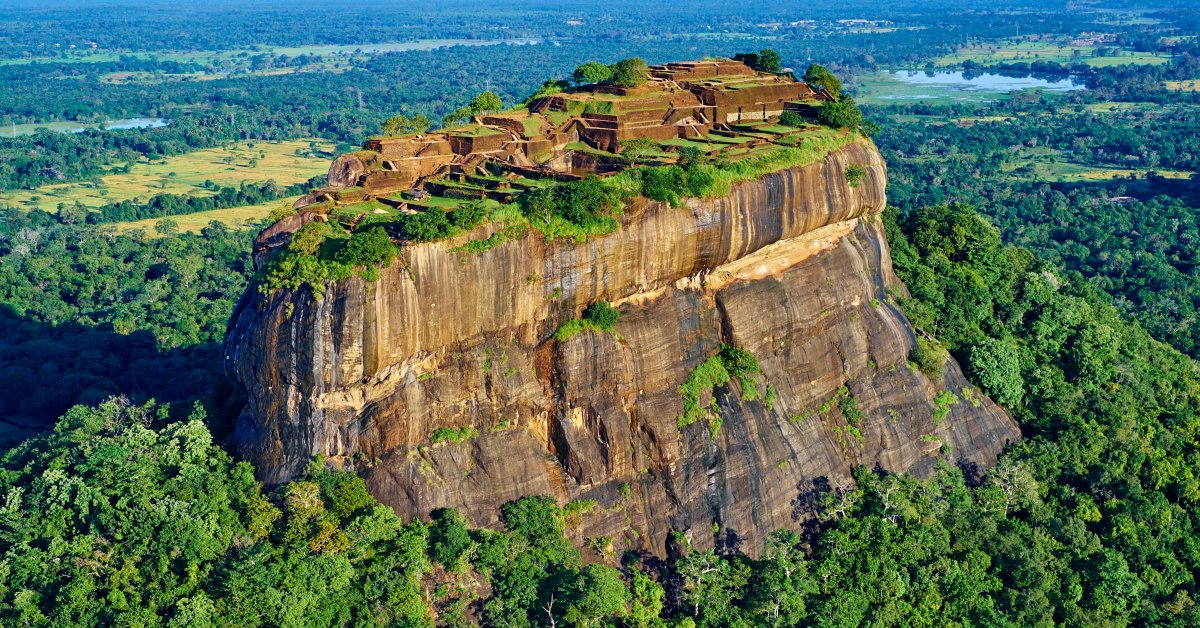This UNESCO World Heritage Site is regarded as the 8th wonder of the ancient world, and that’s by no means a coincidence.

Sigiriya is one of the most fascinating and mysterious archaeological sites in the world. Located in central Sri Lanka, it consists of the ruins of an ancient city that was built on top of a massive rock pillar, rising about 180 meters above the surrounding jungle. The city was founded by King Kashyapa I, who ruled from 477 to 495 CE, after he usurped the throne from his father and killed him.
Kashyapa chose this site as his new capital, and constructed a magnificent palace on the summit of the rock, as well as elaborate gardens, water features, fortifications, and frescoes on the rock walls. He also had a huge lion’s head carved at the entrance to the palace, giving the name Sigiriya, which means “Lion Rock” in Sinhala.

However, Kashyapa’s reign was short-lived, as he was defeated by his half-brother Moggallana, the rightful heir to the throne, who returned from exile in India with an army. Kashyapa died in battle, and his city was abandoned soon after. The palace was converted into a Buddhist monastery, which lasted until the 14th century, when it was also deserted.
Sigiriya remained forgotten for centuries, until it was rediscovered by British explorers in the 19th century. Since then, it has been excavated and restored by archaeologists, and declared a UNESCO World Heritage Site in 1982.

Sigiriya is a remarkable example of ancient urban planning, engineering, art, and architecture. The rock itself is a natural wonder, formed by volcanic activity millions of years ago. The city was designed to harmonize with the natural landscape, and to create a symbolic representation of the cosmic order.
The rock was divided into three levels: the lower level consisted of a moat and a wall that encircled the base of the rock, as well as terraced gardens that were irrigated by an advanced hydraulic system; the middle level consisted of a series of galleries and staircases that led to the upper level, as well as caves that served as dwellings for monks and ascetics; and the upper level consisted of the palace complex, which included a throne room, audience hall, bathing pools, and royal chambers.


One of the most striking features of Sigiriya are the frescoes that adorn the western face of the rock. These paintings depict beautiful female figures, who are believed to be either celestial nymphs or royal consorts of Kashyapa. The frescoes are executed in a style that is unique to Sri Lanka, combining elements of Indian and Persian influences.
The paintings are remarkable for their vibrant colors, graceful poses, and exquisite details. Only about 20 frescoes survive today, out of an estimated 500 that originally covered an area of 1400 square meters.

Another remarkable feature of Sigiriya is the Mirror Wall, which runs along the western side of the rock. This wall was originally covered with a highly polished white plaster, which reflected the sunlight and created a mirror-like effect.
Originally this wall was so reflective that the king could see himself as he walked alongside it.

The wall also contains hundreds of graffiti inscriptions, dating from the 6th to the 14th centuries. These inscriptions are written in Sinhala script, and express various sentiments of admiration, love, humor, and criticism by visitors who came to see the frescoes.
The inscriptions provide valuable insights into the social and cultural history of Sri Lanka during this period. Individuals from various backgrounds, ranging from poets and provincial governors to housewives, engaged in inscribing on walls. Even bhikkhus were not an exception; they composed poems on a range of topics, including love, irony, and diverse personal experiences. This stands as the sole surviving testament of poetry during the Anuradhapura period.

Sigiriya is a site that inspires awe and wonder in anyone who visits it. It is a testament to the vision and ambition of Kashyapa, who created a city that rivaled any other in his time.
It is also a testament to the skill and creativity of the ancient Sri Lankans, who transformed a natural rock into a masterpiece of art and architecture.

Sigiriya is a site that challenges us to unravel its secrets and mysteries, and to appreciate its beauty and splendor.
Sources: 1, 2, 3, 4
